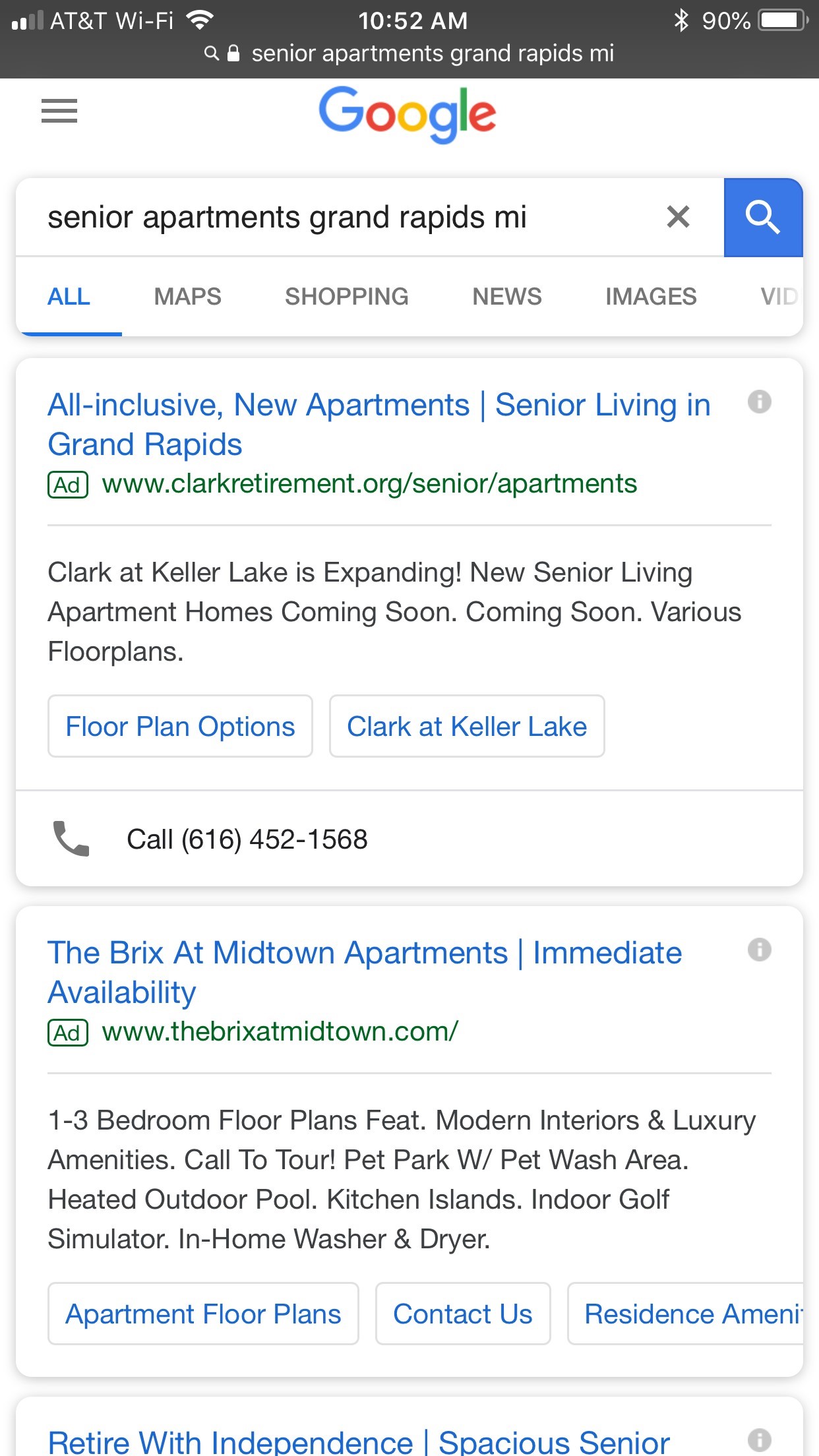Remember Ask Jeeves? It was a search engine that allowed you to type in a question, such as “What is respite care?” and the Jeeves character would find multiple answers to match your query.
Now we ask our devices, like Google Home, questions such as, “What senior living communities offer respite care in Philadelphia?” And our devices respond with the top search results in the local area.
What these inquiries have in common is that they are formatted as questions that now also involve intent. As consumers search the web, they are looking for platforms to give answers to that will help them meet a need. Consumers have shifted from searching broad terms like “respite care” and are more focused on the action they want to accomplish.
To aid this process, Google Adwords (now Google Ads) and Bing Ads have implemented new features to help searchers find the best answers to their questions.
Expansive Text Ads
Expanded text ads originally included a second headline and a longer description when they were first introduced. This was seen as an improvement to the standard ad that included just one headline and one description.
Businesses were able to provide more copy to better promote why their product or service was a good match for the prospect. According to Wordstream, Google noticed better click-through rates and continued to build upon its expanded text ad services. Bing followed suit and, suddenly, the only ads appearing at the top of the search engine results pages were the new expanded text ad format.

Expanded text ads were update once again in mid-2018. Now, they can include as many as three headlines and two descriptions. The increased real estate is an attempt to adapt to the changing needs of people searching for products and services online. Prospects are asking more intent-based questions and larger devices enable businesses to provide more in-depth answers using the new expanded ad format.
There’s no need to worry though. As of this writing, your original expanded text ads will not be phased out over time like the standard ads were — yet!
Responsive Search Ads
Although still in the testing phase, Google continues to adjust ads to show more relevant messages to the searcher. Responsive ads allow Google to show multiple variations of headlines and descriptions to create ads more tailored to the searcher based on the theme of their search query. Below, you’ll find examples of 3 different ads, triggered by three different searches and the assumed intent of each:



Some benefits to responsive ads include:
- Saving Time: who doesn’t love that this time of year? One responsive ad can create 3 to 4 to 5 ads for Google to show.
- Extending Your Reach: Make your dollar go farther by giving Google multiple variations that help marry the searchers’ intent to your ads.
- Improving Ad Group Performance. Compete in more auctions due to the increase in ads within your ad group.
Ad Position Metrics
With all the additional ad space, Google has decided to now show four ad position metrics to give a little more clarity of where your ad will appear. These metrics include:
- Impression (Absolute Top) %: this is the number one spot on the search engine results page, including organic searches (mobile example below).
- Impression (Top) %: this position is still above the organic results but will show in any of the top ad positions.
- Search (Absolute Top) Impression Share: your ad impressions in the absolute top position divided by the projected/eligible impressions of the absolute position.
- Search (Top) Impression Share: your ad impressions in the top positions, above organic, divided by the projected/eligible impressions of the top positions that are above organic.

Clark Retirement is at the Absolute Top position.
Google Exact Match
Google match types have also been updated this year. Match types were previously sorted into the following categories:
- Broad Match: your ad is eligible to appear whenever a user’s search query includes any word in your key phrase, in any order
- Modified Broad: similar to broad, although adding the plus sign in front of a term in your keyword tells Google that the search query must include that term.
- Phrase Match: this match type adds a higher level of control, where your ad will only appear when a user queries your key phrase using your keywords in the exact order you enter them. Queries can include other words either before or after that phrase.
- Exact Match: previously, with this match type, users would only see your ad when they typed your exact keyword phrase by itself. However, Google has updated the exact match type to allow for the searcher’s intent.
Exact match now allows Google to show your ad when they determine the intent is the same. This means variations, synonyms, plurals or implied words and paraphrases are now categorized as exact match.
For example, if the targeted keyword for your ad is “Boston senior community,” it’s possibly that a search query for “retirement communities near Boston” could trigger your ad if Google considers the intent of the search to be the same. Because of this change, we recommend taking a look at your negative keywords. Make sure your negative keywords are set so that they have more ad triggering control.
Going the Paid Search Distance
Paid search campaigns will continue to evolve alongside the searcher and with a new year quickly approaching, now is the time to optimize your search campaigns to make a bigger bang in 2019.
Get More Insights with eNews
Sign up for eNews to keep up with the latest mature marketing insights, as well as the latest trends in the 55+ and senior living industries.



